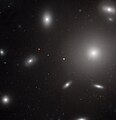Податотека:NGC 4874 HST.jpg

Големина на овој преглед: 578 × 600 пиксели. Други разделности: 231 × 240 пиксели | 463 × 480 пиксели | 740 × 768 пиксели | 987 × 1.024 пиксели | 1.973 × 2.048 пиксели | 3.864 × 4.010 пиксели.
Изворна податотека (3.864 × 4.010 пиксели, големина: 5,95 МБ, MIME-тип: image/jpeg)
Историја на податотеката
Стиснете на датум/време за да ја видите податотеката како изгледала тогаш.
| Датум/време | Минијатура | Димензии | Корисник | Коментар | |
|---|---|---|---|---|---|
| тековна | 13:55, 20 септември 2011 |  | 3.864 × 4.010 (5,95 МБ) | Jmencisom |
Употреба на податотеката
Податотекава се користи во следнава страница:
Глобална употреба на податотеката
Оваа податотека ја користат и следниве викија:
- Употреба на ar.wikipedia.org
- Употреба на arz.wikipedia.org
- Употреба на ast.wikipedia.org
- Употреба на az.wikipedia.org
- Употреба на be.wikipedia.org
- Употреба на ce.wikipedia.org
- Употреба на cs.wikipedia.org
- Употреба на de.wikipedia.org
- Употреба на diq.wikipedia.org
- Употреба на en.wikipedia.org
- Употреба на et.wikipedia.org
- Употреба на eu.wikipedia.org
- Употреба на fr.wikipedia.org
- Употреба на hr.wikipedia.org
- Употреба на it.wikipedia.org
- Употреба на ja.wikipedia.org
- Употреба на kk.wikipedia.org
- Употреба на ko.wikipedia.org
- Употреба на nl.wikipedia.org
- Употреба на pl.wikipedia.org
- Употреба на ru.wikipedia.org
- Употреба на sk.wikipedia.org
- Употреба на sl.wikipedia.org
- Употреба на tt.wikipedia.org
- Употреба на uk.wikipedia.org
- Употреба на uz.wikipedia.org
- Употреба на www.wikidata.org
- Употреба на zh.wikipedia.org
